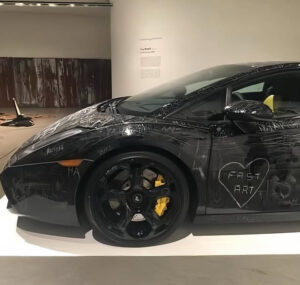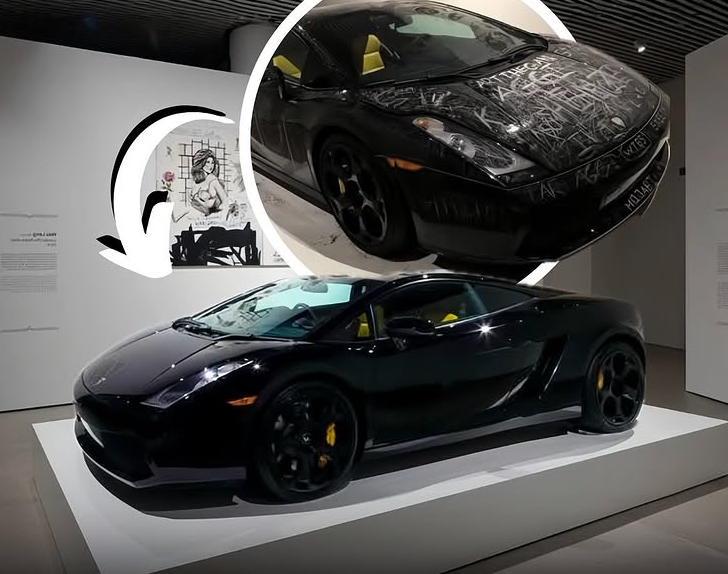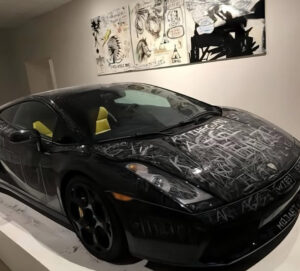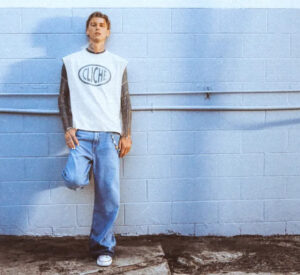
In September 2017, visitors to the ARoS Aarhus Art Museum in Denmark encountered a surprising invitation: scratch a Lamborghini. The car—a matte-black Gallardo—wasn’t damaged in a crash, nor was it a relic. It was intact, gleaming, luxurious, and uniquely positioned in a museum gallery. The invitation came from Norwegian street artist Dolk, whose installation Low Key transformed the car into an open-source canvas. The audience was asked to participate by scratching into its surface with keys or sharp tools.
What emerged was not just a defaced car, but a piece of participatory artwork layered with meanings—on privilege, destruction, public authorship, and the evolving role of institutional spaces.
About the Artist: Dolk
Dolk Lundgren, born Andreas Hamran Færø in 1979, hails from Bergen, Norway. Often referred to as “Norway’s Banksy,” Dolk gained international fame for his stencil-based street art, which combines humor and social critique. His early career flourished on outdoor walls in cities across Europe, and by the mid-2000s, his work had entered the gallery circuit.
He retains an affinity for public interaction, with past projects including installations on abandoned homes in Lofoten and graffiti murals in urban railway stations. With Low Key, Dolk brought this impulse for public engagement into the confines of a contemporary art museum—blurring boundaries between vandalism and conceptual expression.
The Setting: ARoS Aarhus Kunstmuseum
ARoS is one of Scandinavia’s largest and most forward-looking art museums. Known for its rainbow-colored rooftop by Olafur Eliasson and its devotion to bold contemporary projects, ARoS has consistently pursued provocative exhibitions.
In 2017, as part of the group exhibition No Man Is an Island – The Satanic Verses, the museum curated works that questioned how individual actions contribute to collective conditions. Dolk’s Low Key was included as a dramatic centerpiece.
The Installation: Low Key
The artwork centered around a matte-black Lamborghini Gallardo, a car universally recognized as a symbol of extreme luxury. Dolk and his gallerist Sjur Nedreaas purchased the vehicle from Italy specifically for this work. It was displayed on a white platform in a sterile gallery space. Instead of ropes or protective glass, visitors were given permission—no, encouragement—to scratch the car.
Within hours of opening, tentative inscriptions gave way to energetic scrawls. Visitors carved their names, initials, phrases, even jokes. One etched “SKODA” across the rear, ironically referencing a more humble European car brand. Windows were scratched, letters were peeled off the Lamborghini logo, and layered inscriptions began to cover every visible surface.
A Symbol of Excess
The choice of a Lamborghini was intentional. As curator Pernille Taagaard Dinesen explained, a common car wouldn’t have created the same tension. The Gallardo symbolizes exclusivity and desire. By giving the public free rein to destroy it, the work confronted viewers with questions about privilege, value, and the allure of wealth.
Action and Consequence
The installation was framed around the idea that “every action leaves a mark.” Visitors were literally inscribing their presence onto a shared object. In doing so, they became co-authors of the work. Their participation was both physical and ideological—a representation of how small, individual actions shape a society.
Context and Consent
Importantly, the destructive behavior was sanctioned. Outside the museum, keying a car would be a criminal act. Inside the museum, it became a form of expression. This duality highlights the power of context. The same act, reframed by environment and permission, shifts from vandalism to art.
Museum Response and Public Reaction
After three weeks, museum officials ended the scratching process. The surface had become so etched that it was feared the car would turn completely white, erasing the contrast and complexity of the markings. Only two letters from the original “Lamborghini” logo remained intact.
The museum posted signs reminding visitors that this kind of behavior should not extend beyond the museum. Dinesen emphasized that the purpose of the piece was to provoke self-reflection—not copycat acts in real life.
Online, the reactions were mixed. On forums like Reddit, some hailed the piece as “beautiful,” while others called it “ridiculous” and “pointless destruction.” Media outlets including Oddity Central, Jalopnik, and Wonderful Engineering covered the project with fascination, often noting the absurdity of such a high-end item being used in this way.
Destruction as Creation
Low Key challenges the traditional notion that art must preserve or elevate. Here, destruction became the mechanism of creation. The Lamborghini, once a pristine object of capitalist desire, was reborn through its scars. It became an archive of interaction, documenting hundreds of anonymous stories.
Street Art Ideology in a Museum
Dolk’s project brought the ethos of street art—ephemeral, unauthorized, and anti-institutional—into a white-cube environment. By allowing public participation, he disrupted the typical hierarchy of artist/viewer and creator/audience.
The Politics of Flow
The work also critiques consumerism and the fetishization of material goods. In a world where billionaires collect cars like trophies, Low Key repositions the Lamborghini as something to be handled, changed, and collectively repurposed—its value transformed from economic to experiential.
What Happened Next?
After the installation period ended, the scratched Gallardo remained on view through September 2017. It was then returned to Dolk. Whether the vehicle remains in his possession or has since been repurposed or resold is unclear, but speculation abounds that its value may have actually increased—now a unique artifact of public performance and institutional critique.
Legacy and Influence
Low Key left a lasting impression. It pushed the boundaries of what contemporary art can be—interactive, destructive, and deeply philosophical. It continues to be referenced in discussions about participatory art and the ethics of audience interaction.
For Dolk, it marked a definitive crossover moment, demonstrating that street artists can challenge and reshape museum practices without losing the urgency of their message. For ARoS, it was a bold programming decision that reinforced its status as a museum willing to court controversy in the name of dialogue.
Interpretation
Dolk’s Low Key remains one of the most provocative public art installations of the 2010s. It transformed an opulent object into a vessel of shared authorship, invited destruction within curated bounds, and used the car—a symbol of speed, ego, and desire—as a slow-burning monument to our collective psyche.
Through this project, Dolk challenged viewers to consider the nature of value, the power of participation, and the fine line between action and responsibility. The scratches were not mindless—they were meaningful. They told us who we are when no one tells us “no.” And in the end, that is what makes Low Key endure: it was never about the car—it was about us.
No comments yet.









